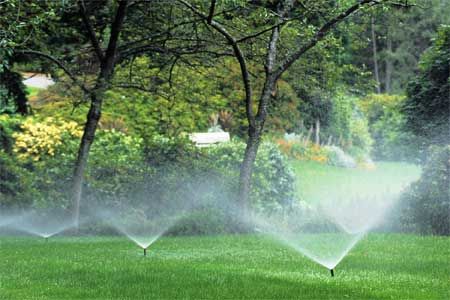It’s that time of year again, when water becomes the essential elixir in your garden. Plentiful spring rains are past, and the summer sun beats down relentlessly, scorching plants, lawns, and trees. You water, of course, but is it enough? Is it at the right times? Why is it so hard to keep everything from drying out?
The first things you can do to protect your plants actually happen long before summer. Always be sure to prep your soil before you plant, since soil that’s been enriched with organic material will hold water better than a sandy, gravelly soil. Also, plant in prepared beds. Plants that go into beds of prepared soil, instead of into individual planting holes, will grow large, spreading root systems. The larger a plant’s root system, the less water it takes to sustain it. The same holds true for lawns. Lawns planted on a six- to eight-inch layer of good loam will grow a strong, deep root system that will help it survive dry periods.
You can also make your life a little easier if you plan your landscaping around watering needs. Shallow-rooted plants such as hydrangea, azalea, and rhododendron require more watering than other plants. Annuals and container plants also need extra attention come summer. Think about that as you plant, and group the high-water-need plants together. Come July and August, as you’re making the rounds with the hose or watering can, you’ll be glad you did.
You can also use mulch to help you save water. Many people mulch their planting beds to hold in moisture and moderate soil temperature (see May Is for Mulching), but they neglect the annuals and containers. Mulching goes a long way in reducing the amounts of water these thirsty plants need, so don’t forget them when you mulch your beds.
No matter how smart you are about conservation, though, eventually you’ll have to water. The main question people usually have about watering, especially about their lawns, is: how much?
The simple answer is that lawns require about an inch of water a week. The tricky part is to figure out how to translate that inch of water into minutes on your sprinkler. There’s no way around it, you have to measure. Set up your sprinkler as usual and put out a rain gauge, which can be as simple as an empty coffee can. Water for 15 or 20 minutes, then check how much water is in the can. If you water for 15 minutes and get 1/4 inch of water, you know you need four times that amount of time to get to an inch. That means you need 60 minutes of watering a week to keep the lawn healthy. If 15 minutes on your sprinkler provides half an inch of water, you only need 30 minutes total a week.
But don’t do a week’s worth of watering all at once (the ground probably can’t absorb it and water will run off), and don’t water a few minutes every day (the top layer will stay soggy and water won’t get down to the roots). Instead, you should water three times a week, for a third of your required minutes each time, with a day or two off in between waterings. Don’t forget to subtract for rain. Try to water as early as possible in the morning, as long as it doesn’t interfere with showers!
Automatic sprinkler systems are a great way to water, but there are some key points to using them. First, lawns have different requirements than trees and shrubs, so a sprinkler system should be broken out into different zones to accommodate these different needs. Second, don’t use the system when you don’t need it. Too many people run sprinklers in the spring and fall when natural rainfall is plentiful, or they allow their systems to run during a rainfall. Use a rain gauge or the precipitation report in the paper to tell you when to turn the system on, and get a sensor to keep the sprinklers from turning on during a rainy period.
When it comes to plants, trees, and shrubs, take advantage of some new products to keep the water flowing. Drip bags are especially useful with new plantings. Simply set these plastic bags on top of the root ball of a new tree or shrub and fill it with water ? they slowly release the water over several hours. You can also add in liquid fertilizer at the same time.
Drip hoses are also great — they’re full of tiny holes, so you just loop it around a group of trees and shrubs and turn on the spigot. Water is released along the entire length of hose. Look for one made of recycled rubber (we love to recycle), and you can buy or make metal staples to hold the hose in place. Be sure to read the manufacturer’s directions before you use it — too much water pressure can cause a drip hose to fail.
With these tips in mind, you should be able to get your garden through the heat of summer unscathed, ready for the cooler days ahead.

